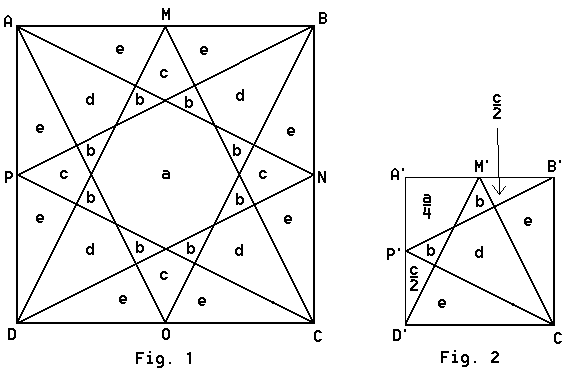Solving the Square Dance

First off, I'd like to say that this is an extremely fun and interesting problem, and there are a myriad of ways to solve it, so if you want to have fun doing it you'd better turn back now. My old solution is still up, at the other site, but this one is more spiffy, quick, and new.
The first step, of course, is to draw the diagram. You can see this in Figure 1 of the picture. I've labeled each of the regions in the diagram because it's easier to represent things as variables this way. Notice that Figure 2 is simply the bottom-right quarter of Figure 1, relabeled to show the relationships. Since the lines have the same slope and go through the same corners, they're similar figures, and so an area in Figure 2 will have an area of exactly 1/4 of its corresponding area in Figure 1. Each bullet point here is one block:
- Take a look at the lower e section in Figure 2. Comparing it with Figure 1, since we can see that the area of triangle CDP is 1/4, e = 1/4 (1/4 - e). Solving this equation gives us that e = 1/20.
- Now, look at the lower c/2 section in Figure 2. Since it corresponds to an e section in Figure 1, c/2 = 1/4 (e), and since we know e we can say that c = 1/40.
- This is slightly more difficult to see, but a b section in Figure 2 corresponds to both a c and a b section together in Figure 1. This means that b = 1/4 (b + c), and knowing c gives us that b = 1/120.
- If we look at triangle CDP again, its area is 1/4, and so b + c + d + 3*e = 1/4, which gives us that d = 1/15.
- And, finally, a/4 in Figure 2 corresponds to 2*e + d in Figure 1, so a/4 = 1/4 (2*e + d) and so a = 1/6. We're done!
The final area list: a = 1/6; b = 1/120; c = 1/40; d = 1/15; e = 1/20. The center square is composed of 4*b + a and thus has area 1/5.
There are some weird things going on here... notice that all of the sections' areas are the whole square's area divided by an integer? There are a lot of multi-section areas that behave like this too; for example, the triangle composed of e + c + b has area 1/12. Isn't that weird? Also, if you move some of the e regions around, you can create a cross pentomino shape (can you see how?). This explains why this cross tesselates the plane. And finally, there are some great origami applications of this, which I'll leave you to figure out... Definitely worth looking at. I love this problem.